
$220 SAVE $130 = 37.0% Western Digital 16.0TB Western Digital Ultrastar DC HC550 3.5-in… in Storage: Hard Drives
|

$500 SAVE $75 = 13.0% OWC 1.0TB OWC Atlas Pro SDXC V60 UHS-II Memory Card (2-Pack) in All Other Categories
|

|

|

|

|

|

|

|

|

|

|
Depth of field: the shorter focal-length advantage
Related: circle of confusion, depth of field, digital sensor, exposure, field of view, optics, shutter
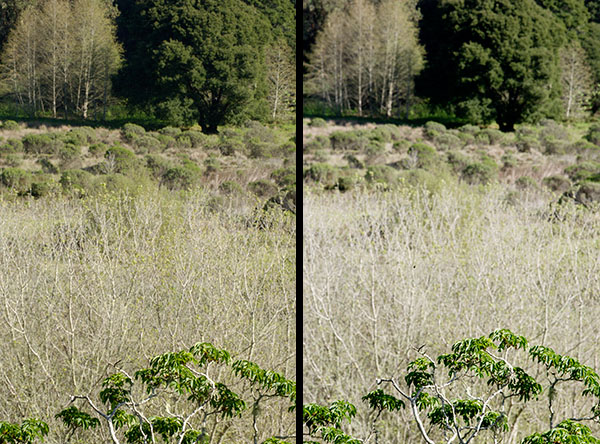
This is an excerpt from the 2005 D2X vs EOS review, now located in DAP.
Depth of field is a function of aperture and shooting distance. It is also a function of focal length, but this is a 2nd-order effect noted mainly when doing close-up work. When depth of field is described, it is in relation to a circle of confusion, the smallest dot that is considered “sharp”. A discussion of depth of field or a depth of field table is misleading without also stating this circle of confusion unless it is a relative comparison, as this discussion is. For that matter, the “circle of confusion” is not a uniform blob, and other effects come into play to alter the perception of sharpness.
Increasing depth of field
Assuming the same aperture, there are two ways to increase depth of field:
• Without changing the focal length, increase the distance from camera to subject. Crop the resulting image to the original composition. This approach loses resolution (cropping), and changes the perspective (relative size of items) and thus results in a completely different image.
• Keep the camera at the same position and use a shorter focal length. This expands the angle of view, but the perspective (relative size of items) remains unchanged. Crop the resulting image to the original composition.
The camera forces the decision: to frame the subject as desired, one must either move the camera and/or use a different focal length. Where digital has confused this issue is by introducing cameras with different-size image sensors, which in effect crops the image as compared with a camera utilizing a larger sensor. But note well:
For example, the Nikon “DX” sensor found in all Nikon digital SLRs except the D3 is only 2/3 the size (linearly) of the full-frame 36mm X 24mm sensor used in the Canon EOS 1Ds Mark II.
Examples — Nikon D2x and Canon EOS 1Ds Mark II
Look at the examples, then see the conclusion at the end of this page for how this works out in practice.
All shots D2X on the left, 1DsMII on the right. These are the full-frame image (not crops) down-sampled but not sharpened.

f/16
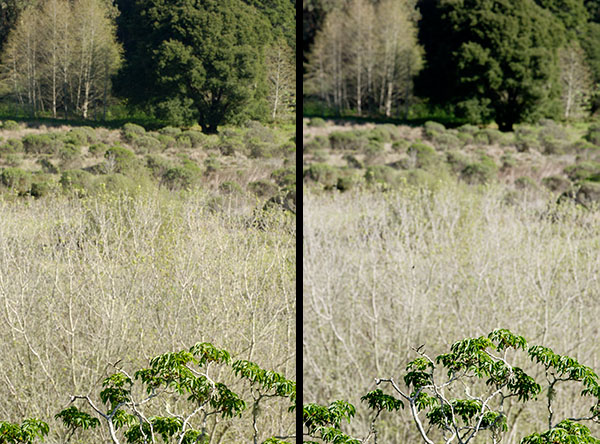
f/11
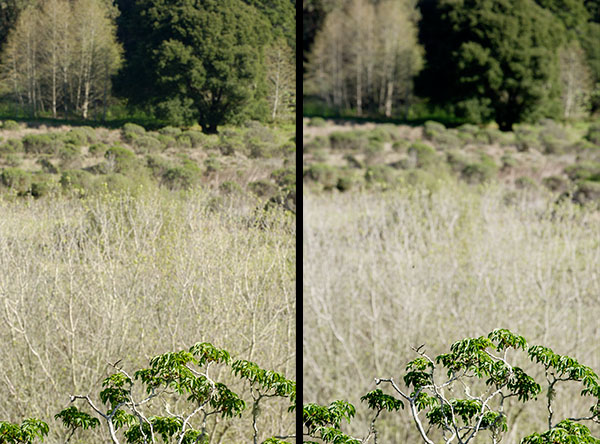
f/8
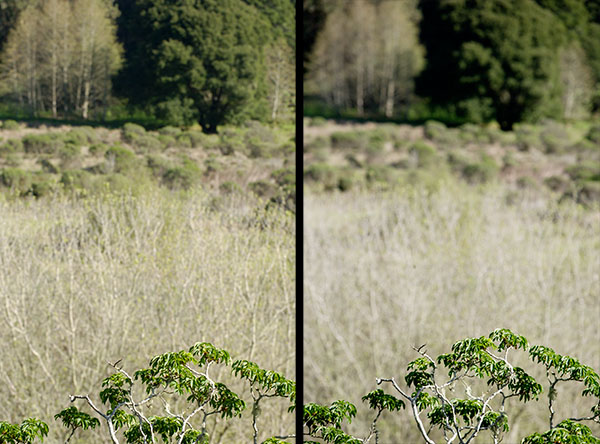 f/5.6
f/5.6
Now let's examine some actual-pixels crops at f16 from each camera (D2X images were up-rezzed to match size). The D2X image is on the top and the 1DsMII image is below it. Note that both cameras lost highlight detail. Identical exposures were used, but it appears that I slightly overexposed the 1DsMII shot. However, that does not invalidate the depth of field comparison.
The focus point was near the top green leaf at lower center. The 1DsMII does appear to resolve slightly more detail in the leaves than the D2X does. Sharpening would narrow this apparent difference. But the compelling observation here is that there is a far larger difference in the sharpness of the area beyond the focus point.
Below are the foreground (closest to the camera) actual-pixels crops:

Near (actual pixels)
D2x at top, 1DsM2 at bottom
Shown below is the background (farthest from the camera) actual-pixels crop:
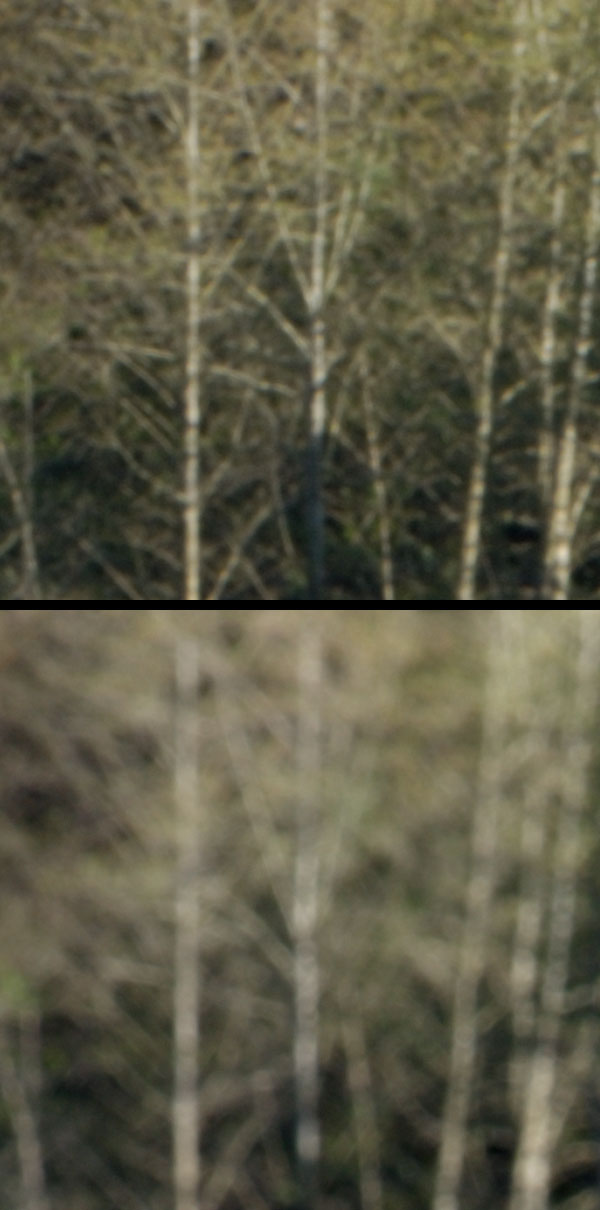
Far (actual pixels)
D2x at top and 1DsM2 at bottom
Conclusion
To adapter the discussion below to any brand or model of camera, mentally substitute “smaller sensor” in place of “D2x”, and “full-frame sensor” in place of 1DsMII.
If you are shooting where significant depth of field is required, the D2X might better serve your needs, producing more sharp pixels overall than the 1DsMII. Or, the D2X will be able to shoot at a higher shutter speed while obtaining the same DOF. When the wind is blowing, details like leaves or flowers can be obliterated by a too-low shutter speed. When it's dusk, you may not be able to stop down to get DOF and still get a fast-enough shutter speed. You can raise the ISO on the 1DsMII, but that degrades picture quality. And in these examples, even f/16 was not enough to make up for the disadvantage. Going beyond f/16 on either camera seriously degrades overall image sharpness and contrast (see Diffraction), though in this case perhaps it would be an improvement for the 1DsMII.
If your photographs involve selective focus such as head or torso shots of people with a pleasantly blurred background, you might be better served by the attractive background blur of the 1DsMII. The Canon 85/f1.2L II is in a class by itself in this regard and cannot be matched on a Nikon body; Nikon does offer the 50mm f/1.2 AI-IS, but its shorter focal length is hardly the same as 85mm. However, in practice I've found that on the D2X I can achieve very pleasant background blur with a number of lenses, including the 50mm/f1.4, the 35mm/f1.4, the 70-200/f2.8VR, the 85/f1.4, the 200VR and others.
8-bay Thunderbolt 3
2.5 or 3.5 inch hard drives, NVMe SSD, USB-C, USB-A, DisplayPort 1.4, SD slot, PCIe slot, 500W power supply.
Non-RAID or RAID-0/1/4/5/10.
Capacities up to 128 Terabytes!
Depth of field—real vs achieved
Depth of field is not a fixed property of aperture and focal length. It is a mathematical concept which can vary with the optical properties (shortcomings) of a real lens. Past research at diglloyd.com has shown that different lenses of the same focal length and at the same aperture can realize significantly different depth of field, both perceptually and objectively. This can be attributed to optical design, and to lens aberrations such as chromatic aberration and spherical aberration. Usually these effects are quite modest, and diminish rapidly upon stopping down.
Notes on how the images were taken
The images were shot with the Canon 70-200/f2.8L IS @ 200mm (marked) and the Nikon 70-200/f2.8 VR at approximately 135mm zoomed to match the Canon. Focus was manual, near the topmost leaf of the foreground tree. The true focal lengths were probably slightly different than the marked values. The images were shot with identical exposures starting with 1/125 sec @ f5.6. However, the 1DsMII produced a much lighter image, so exposure was reduced for the Canon image during raw-file processing by 0.5 stops to have it better match the D2X exposure. The images are the full frame as shot on each camera. The D2X images were up-sampled to match the 1DsMII resolution (3328 wide). Then they were both down-sampled to a smaller size (excepting the actual-pixel crops).
When comparing cameras, it is hard to match the exact field of view between cameras; if nothing else distortion makes it ambiguous at the top/bottom versus center of the frame. Please note that the D2X image in this example has a wider field of view-95% that of the 1DsMII image (I used full-sized images to determine this). An exact match for field of view would mean the D2X was at a focal length of 133mm. But my slight error means the D2X was shot at about 126mm. This gives the D2X image a bit more depth of field than an exact field-of-view match, but is not a factor which influences the conclusion.
It is clear that the D2X has an substantial advantage with depth of field. While the whole picture looks sharp on the D2X, the longer focal length required by the full-frame 1DsMII simply cannot deliver enough depth of field to make a sharp picture overall.
Depth of field calculations
Even the D2X is challenged by this shot. The truth is that these cameras have such high resolution that the conventional depth of field calculations are simply way off the mark for what is actually required to fully utilize the phenomenal sensor resolution. Conventional depth of field tables generally use a "circle of confusion" of 20-30 microns (The circle of confusion or COC is the smallest dot that the lens can resolve at any given aperture). Compare the conventional 20-30 micron figure with the D2X 5.4-micron pixels and the 1DsMII 7.2-micron pixels, and it's clear that depth of field is extremely limited on either camera. The depth of field marks on lenses are far beyond the actual depth of field, good as reference marks and/or for giggles, but not much more.
Bear in mind that actual depth of field is reduced by lens aberrations such as chromatic aberration and spherical aberration. Lenses with significant aberrations may achieve less depth of field than is theoretically possible. This is not a factor with the two lenses used in the comparison shots on this page, both of which are top-quality optics.



















